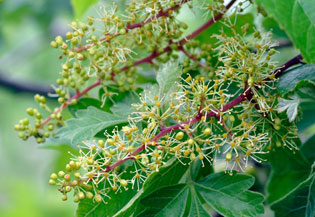PIGEON GRAPE
|
 |
| File Size: 113 KB |
|
|
|
Vitis aestivalis Michx.
|
| Chase County, Kansas |
| Height: Vines to 33 feet long |
| Family: Vitaceae - Grape Family |
| Flowering Period: May, June |
|
| Trunks: | | Stems climbing or clambering; branches unarmed, tips not enveloped by unfolding leaves, tendrils persistent, usually branched, sometimes simple; bark brown, exfoliating in long, thin strips; wood white, soft. | | Twigs: | | Reddish brown to purplish brown, flexible, glabrous; leaf scars crescent-shaped; pith brown; buds ovoid, .16 to .24 inch, apex obtuse to acute, scales glabrate. | | Leaves: | | Deciduous, alternate, simple; petiole 3.2 to 4.8 inches, glabrous or floccose to arachnoid and hirtellous usually with rusty or rarely white hairs; blade cordate to orbiculate, 2.8 to 10 inches long, 1.6 to 10 inches wide, base cordate, margins irregularly and coarsely dentate, unlobed or deeply 3- to 5-lobed, apex acute, lower surfaces grayish green or light green, glabrate or floccose to arachnoid and hirtellous with rusty or rarely white hairs, glaucous, upper surfaces green, glabrous or glabrate. | | Flowers: | | Inflorescences opposite leaves on new growth, thyrses, 15-150-flowered, spreading or lax, 2 to 8 inches; peduncle .4 to 2.8 inches, floccose, glabrescent; pedicels .12 to .16 inch, glabrous.
Flowers dioecious; unisexual, radially symmetric; sepals 5, connate, lobes green, reduced to an obscure rim; petals 5, connate distally, white, oblong to elliptic, .09 to .1 inch; staminate: stamens 5, to .12 inch; pistillate: pistil 1, ovary superior, 2-locular; style 1; stigma 1, lobed. | | Fruit: | | August-September; berries, dark purple to black, globose, .3 to .7 inch diam., smooth, glaucous, glabrous, flesh not milky; seeds 2-4, reddish brown, broadly ovoid, .24 to .26 inch long, .16 to .2 inch wide, smooth. | | Habitat: | | Dry, rocky upland forests and woodlands, thickets, bluffs, fencerows, ravines, stream banks. | | Distribution: | | East 1/6 of Kansas | | Origin: | | Native | | Uses: | | The Cherokee and Choctaw tribes used various parts of the plant to treat a variety of maladies, and the Cherokee used the fruits for food and as a beverage (Moerman 1998). | | Comments: | | Leaf vestiture varies greatly among plants, sometimes within populations. Vitis aestivalis is occasionally confused with V. cinerea; the former has leaves that are abaxially glaucous and usually with rusty hairs (vs. abaxially not glaucous and usually with white hairs) and larger and more strongly glaucous fruits; it generally occurs in drier, better-drained sites. |
|
| Pigeon grape inflorescences |  | | 82 KB | | Chase County, Kansas |
| | Pigeon grape habit |  | | 152 KB | | Schermerhorn Park, Cherokee County, Kansas |
| | Pigeon grape leaf |  | | 95 KB | | Schermerhorn Park, Cherokee County, Kansas |
| | Pigeon grape leaves |  | | 123 KB | | Schermerhorn Park, Cherokee County, Kansas |
| | Pigeon grape leaf undersurface |  | | 122 KB | | Schermerhorn Park, Cherokee County, Kansas |
| | Pigeon grape bark |  | | 64 KB | | Schermerhorn Park, Cherokee County, Kansas |
| | | | |
|
|
|